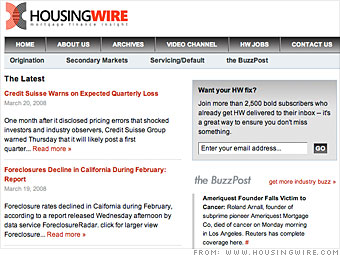By Tom Kelly
Tom DiMercurio has spent nearly 40 years analyzing, managing and selling foreclosed properties.
He is the brains behind BuyBankHomes.com, a Web site that provides foreclosure information to interested parties such as consumers, investors and real estate agents. When a bank finds itself with a ton of real-estate-owned inventory, he’s often called on to propose a liquidation strategy.
Now, DiMercurio is spending his own money in offering a solution to a national foreclosure problem that seems to be getting larger every day. He’s made two trips to the nation’s capital trying to get in front of lawmakers with an idea that he believes could stabilize neighborhoods torn apart by empty homes no longer properly maintained.
He’s written Rep. Barney Frank, D-Mass., the chairman of the House Financial Services Committee, about a meeting to discuss a plan similar to the successful one he devised for the devastated Houston market of 1986-88. He would welcome the chance to chat with James Lockhart, the chief executive and chairman of the Oversight Board of the Federal Housing Finance Agency that oversees Fannie Mae and Freddie Mac, about a fix-and-finance idea that would help eliminate the negative stigma of a foreclosed home.
Here’s the core of the pitch: If Fannie and Freddie (who collectively have more than 100,000 foreclosed homes) allocated $5 billion for rehabilitation of those properties and $20 billion for financing, they could self-finance all of their newly refurbished inventory with low down payments, reduced closing costs, quick turn-around times while removing 100,000 assets without affecting liquidity — allowing that cash for other transactions. Fannie and Freddie would then have a $25 billion book of new loans from borrowers who value the homes.
“My view is this is largely a liquidity-neutral play for Fannie and Freddie,” DiMercurio said. “The $25 billion is non-earning now and the removal of one-eighth of the growing foreclosure inventory would help to stabilize many neighborhoods. It also assists in the very mission of Fannie and Freddie.”
Special financing makes sense, especially now, given the continuing liquidity problems and credit tightening restrictions making the sale of foreclosed and conventional homes increasingly difficult.
How did the nation get into such a predicament?
A decade of cheap money and incredibly flexible loan programs offered by many lenders sparked overbuilding by developers, a flip-and-run mindset for speculators and unrealistic expectations for first-time homebuyers blinded by the low payments of a short-term loan. While the equity gained by rising home prices can cover many ill-conceived loan mistakes, a flat or sinking market only compounds problems for lenders and owners.
DiMercurio managed Fannie Mae’s Houston operation from 1986-88 when one-third of all Fannie Mae’s national foreclosed inventory was situated in the five counties surrounding the nation’s fourth largest city. The Houston experience, in the sheer volume of localized foreclosures and the severity of the absolute value decline from peak to valley, rivaled the worst financial performance in U.S. history.
During the Houston slump, brought on by a declining oil industry, the resale market was challenged by a widely held public view that foreclosed homes were surely the result of a building defect or other shortcoming that made them less desirable than a regular (nonforeclosure) residential property. DiMercurio’s team, working with Fannie Mae in Washington, D.C., conceived a plan to brand “Fannie Mae as the Best Housekeeper in Houston” celebrating the like-new condition of restored Fannie Mae-acquired properties.
Offered with below-market, fixed-interest rates, a maximum of a 97 percent loan-to-value for owner-occupants, reduced closing costs, 30-day closings and refurbishment to a like-new condition, Fannie Mae homes were extremely popular in the Houston residential real estate market for several years.
“Rehabbed homes and self-financing discourage low-price sales to investors who have to make a profit,” DiMercurio said. “They also discourage auctions which often set the bottom value. And, low down payment loans are not counterintuitive. Borrowers pay when they perceive value … that’s why many are not paying now.”
To accelerate the rehabilitation process, Fannie Mae’s Houston office operated like a consolidated real estate disposition and construction company. A contractor/builder partner bought carpet, paint and roofing material by the container load directly from the warehouse, reducing the costs of refurbishing the foreclosed homes.
In order to rekindle the home-buying process, we must find a way to show buyers what they pay for today will not be less tomorrow. More owner-buyers mean stronger neighborhoods.
Tom Kelly’s book “Cashing In on a Second Home in Mexico: How to Buy, Rent and Profit from Property South of the Border” is available in retail stores and at tomkelly.com.
© 2009The Daily Herald Co., Everett, WA
Filed under: Uncategorized | Leave a comment »







.jpg)


